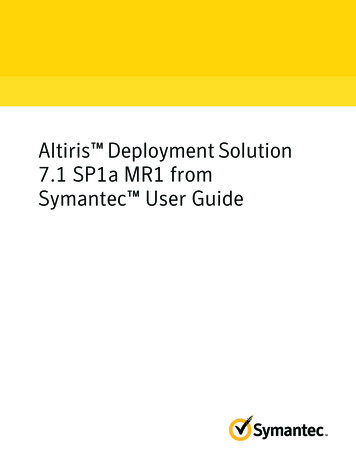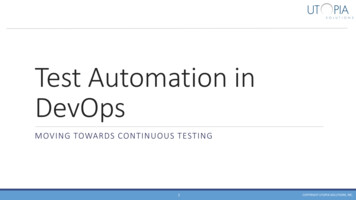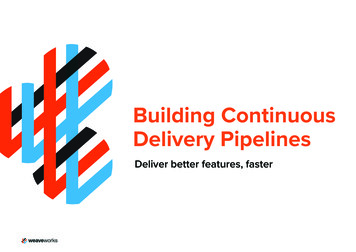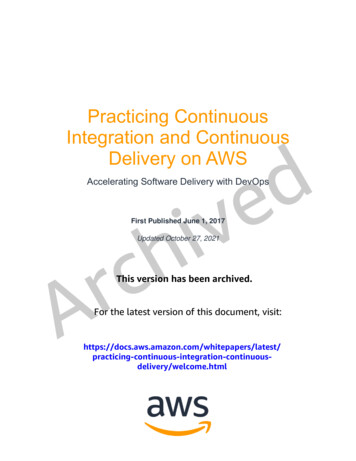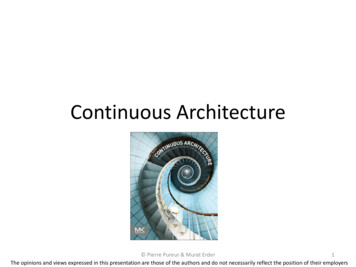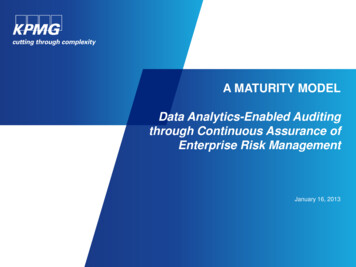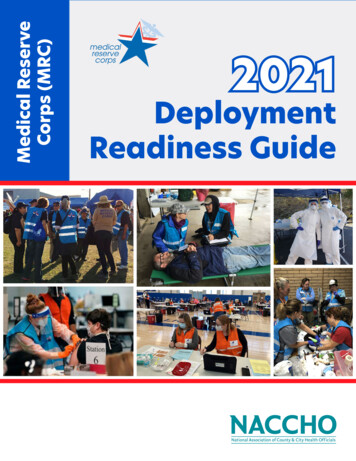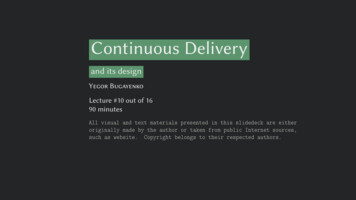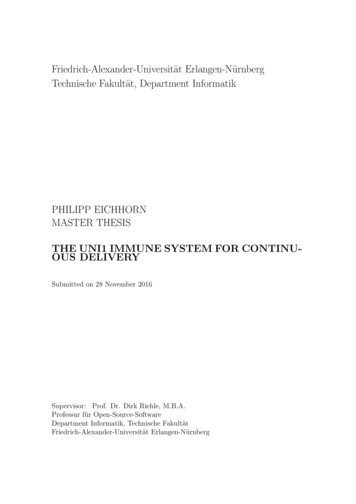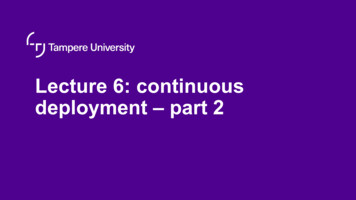
Transcription
Lecture 6: continuousdeployment – part 2
Outline of today Course matters Discussion about ”homework” Continuous Delivery & Deployment5.10.2021 2
Participants (28.10.2021) Total number of enrolled students: Answers to survey: Current participants: Docker exercise: Docker compose exercise: Ansible exercise:28.972636054175.106460595025.10.2021 3
About grade calculationDocker5%Compose 5%AnsibleExercises20%Project40%5%MessageQ 5%EXAM40%0-5Last year:1: 41 - 512: 52 - 623: 63 - 734: 74 - 845: 85 - 1005.10.2021 4
Ansible exercise5.10.2021 5
Backgroud (slide from last imagecontainer5.10.2021 6
Alternative approaches for delivery Set-up everything when image is created Very static Make the container to auto-update You need to know in advance what might change Put stuff to shared folder (use volume) Use configuration tools Work also for full virtual machines and computers5.10.2021 7
Ansible(https://www.ansible.com)Automation engine for Provisioning Configuration Management App Deployment Continuous Delivery Security Automation Orchestrationuses YAML, in the form of Ansible Playbooks
Ansible Ansible works by connecting to your nodes and pushing out small programs,called "Ansible modules" to them. These programs are written to be resource models of the desired state of thesystem. Ansible then executes these modules (over SSH by default), and removesthem when finished. Your library of modules can reside on any machine, and there are no servers,daemons, or databases required. Typically, you'll work with your favourite terminal program, a text editor, andprobably a version control system to keep track of changes to your content. A short video: rt-video
nsibleControlnodeManagedPythonnode
Docker containers as targets Since we do not enough virtual machines,lets use Docker images Complicates the exercise, but allows you to learn more about Docker
Creating the docker image 1/2FROM debianUSER root# Copy application itself:COPY . /homeWORKDIR /homeRUN apt-get updateRUN apt-get install -y nodejsENTRYPOINT node server.jsDebugging aidTime consuming initDocker build –t utest
Creating the docker image 2/21FROMutest2RUN apt-get install -y openssh-server34RUN sed -i 's/PermitRootLogin prohibit-password/PermitRootLogin yes/’/etc/ssh/sshd configRUN apt-get install -y net-tools5RUN useradd -m -s /bin/bash -G sudo -p (openssl passwd -1 eee) ssluser6RUN apt-get install -y python37RUN apt-get install -y sudo89ENV PORT 8894EXPOSE 2210ENTRYPOINT service ssh start && node server.js
SSH support two alternative ways for authenticationPassword Used in the previous slide Not very secure You can use, but gives at most 80% ofthe maximum pointsPublic/private keypair Public key of your computer isinstalled to the host More secure If you want 100% of maximum points,you should use this(building of the image need to bechanged)Info blic-key Long:https://www.ssh.com/academy/ssh/key
Example ansible playbook--- hosts: webserversvars:http port: 80max clients: 200remote user: roottasks:- name: ensure apache is at thelatest versionyum:name: httpdstate: latest- name: write the apache configfile.template:src: /srv/httpd.j2dest:/etc/httpd.confnotify:- restart apache- name: ensure apache isrunningservice:name: httpdstate: startedhandlers:- name: restart apacheservice:name: httpdstate: restarted
Apt vs yumOperating SystemFormatTool(s).debapt, apt-cache, aptget, dpkgUbuntu.debapt, apt-cache, aptget, dpkgCentOS.rpmyumFedora.rpmdnfFreeBSDPorts, .txzmake, pkgDebian
Sidenode apt vs yumexamplesTaskInstall fromrepositoryapt (deb)apt-get install pkgnameyum (rpm)yum install pkgnamezypper (rpm)zypper install pkg-nameUpdate packageapt-get install pkgnameyum update pkgnamezypper update t package pkg-nameRemove packageaptget remove pkgnamedpkg -i pkg-nameyum erase pkgnamezypper remove pkgnameInstall frompackage fileyum localinstall pkg- zypper install pkg-namename
There can bemultiple plays
The exercise in short Read Ansible tutorial to understand how it works. A good starting point is:https://docs.ansible.com/ansible/latest/user guide/intro getting started.html Prepare a docker image that can be used as a target. See details in below. Install Ansible in your computer. Make simple playbook Check that the image has the latest version of git version management system Queries the uptime (Linux command uptime) of target host Return result to Plus
Testing your Ansible1. Start one container from the image, get its IP-address.(in case of password-based authentication you need a manual login after start)2. Ensure that the IP address is in /etc/ansible/hosts3. Run the playbook4. Copy the output (O1)5. Run the playbook again6. Copy that output, too (O2)7. Start a second contained from the image, get its IP-address.8. Ensure that this IP address is in /etc/ansible/hosts, too.9. Run the playbook10. Copy the output (O3)11. Run the playbook again12. Copy that output, too (O4)
Submission Git link of the code (teacher may want do git clone). Usedifferent folder or subrepo from earlier exercises. The report should have a “report.pdf” with the followingcontents. All the copied output (O1,O2,O3,O4) Comments on what was easy and what was difficult.
Main es/) Build quality in Work in small batches Computers perform repetitive tasks, people solve problems Relentlessly pursue continuous improvement Everyone is responsibleSound familiar from somewhere?
CI – essential practices(according to Humbley and Farley) Don’t check in on a broken code Always run all commits tests locally before committing, or get your CI serverto do it for you Wait for commit tests to pass before moving on Never go home on a broken build Always be prepared to revert to the previous revisions Time-box fixing before reverting Don’t comment out failing tests Take responsible for all breakages that result from your changes Test-driven development5.10.202123
Deployment essential pract.(according to Humbley and Farley) Only build your binaries once Deploy the same way to every environment Smoke-test your deployments Deploy to copy of production Each change should propagate through the pipeline instantly If any part of pipeline fails, stop the line5.10.202124
Back to CD5.10.2021ssss25
Continuous delivery and )05.03.201826
Perceived benefits Improved delivery speed of software changes Improved speed in thedevelopment and deployment of software changes to production environment. Improved productivity in operations work. Decreased communication problems,bureaucracy, waiting overhead due to removal of manual deployment hand-offsand organisational boundaries; Lowered human error in deployment due toautomation and making explicit knowledge of operation-related tasks to softwaredevelopment Improvements in quality. Increased confidence in deployments and reduction ofdeployment risk and stress; Improved code quality; Improved product value tocustomer resulting from production feedback about users and usage. Improvements in organisational-wide culture and mind-set. Enrichment andwider dissemination of DevOps in the company through discussions anddedicated training groups ‘communities of practice’
Maturity models in software engineering The first welknown was Capability Maturity Model developed by Software Engineering Institute atCarnegie Mellon University in 1986 Five levels: Initial (chaotic, ad hoc, individual heroics) - the starting point for use of a new or undocumentedrepeat process. Repeatable - the process is at least documented sufficiently such that repeating the same stepsmay be attempted. Defined - the process is defined/confirmed as a standard business process Capable - the process is quantitatively managed in accordance with agreed-upon metrics. Efficient - process management includes deliberate process optimization/improvement. Practical meaning may be questioned, but there has been many followers.5.10.2021ssss28
Maturity model for elivery-maturity-model/was at developer.ibm.com) Base: The base level is enough to “be on the model”.The team has left fully manual processes behind. Beginner: At the beginner level, the team is trying to adopt some ECD practices inearnest but is still performing them at a rudimentary level. Intermediate: Practices are somewhatmature and are delivering fewer errors and more efficiency.For many teams, Intermediate practices may be sufficient. Advanced: doing something well beyond what most of the rest of the industryand is seeing a great deal of efficiency and error prevention as a result. Extreme: Elements within the Extreme category are ones that are expensive toachieve but for some teams should be their target. Put another way, mostorganizations would be crazy to implement them, while this minority would becrazy to not implement them.
Delivery-Maturity-Model/)Base started to prioritize work in backlogs, have some process defined which is rudimentarily documentedand developers are practicing frequent commits into version control.Beginner teams stabilize over projects and the organization has typically begun to remove boundaries byincluding test with development. Multiple backlogs are naturally consolidated into one per team and basicagile methods are adopted .Intermediate extended team collaboration when e.g. DBA, CM and Operations are beginning to be a partof the team or at least frequently consulted by the team. Multiple processes are consolidated and allchanges, bugs, new features, emergency fixes, etc, follow the same path to production. Decisions aredecentralized to the team and component ownership Advanced team will have the competence and confidence it needs to be responsible for changes all theway to production. Continuous improvement mechanisms are in place releases of functionality can bedisconnected from the actual deployment, which gives the projects a somewhat different role. A project canfocus on producing requirements for one or multiple teams and when all or enough of those have beenverified and deployed to production the project can plan and organize the actual release to users separately.Expert some organizations choose to make a bigger effort and form complete cross functional teams thatcan be completely autonomous. With extremely short cycle time and a mature delivery pipeline, suchorganizations have the confidence to adopt a strict roll-forward only strategy to production failures.
Delivery-Maturity-Model/)Base one or more legacy systems of monolithic nature in terms of development, build and release. Manyorganizations at the base maturity level will have a diversified technology stack but have started toconsolidate to get best value from the effort spent on automation.Beginner the monolithic structure of the system is addressed by splitting the system into modules thiswill also naturally drive an API managed approach to describe internal dependencies and also influenceapplying a structured approach to manage 3rd party libraries importance of applying version control todatabase changes will also reveal itself.Intermediate. a solid architectural base for continuous delivery feature hiding for the purpose ofminimizing repository branching to enable true continuous integration. modularization will evolve intoidentifying and breaking out modules into components that are self-contained and separately deployed. start migrating scattered and ad-hoc managed application and runtime configuration into version controland treat it as part of the application just like any other code.Advanced. split the entire system into self contained components and adopted a strict api-basedapproach to inter-communication so that each component can be deployed and released individually every component is a self-contained releasable unit with business value, you can achieve small and frequentreleases and extremely short release cycles.Expert some organizations will evolve the component based architecture further and value the perfectionof reducing as much shared infrastructure as possible by also treating infrastructure as code and tie it toapplication components. The result is a system that is totally reproducible from source control, from the O/Sand all the way up to application.
Simplified pipelineDevelop& testVMSC PythonBuildTestPackDeployOperate
Build – which tools you know ? Make Old Declarative Hard to debug Ant Designed for Java Based on XML-based configuration language Maven
ivery-maturity-model/was at developer.ibm.com)BUILDING
Testing Automate, automate, automate Know any nalacceptance tests)ShowcaseUsability testingExploratory testingUnit testsIntegration testsSystem testsNonfunctonalacceptance ct
ivery-maturity-model/was at developer.ibm.com)TESTING
Pack Binaries Required Libraries Runtime (e.g. Python) Manifest file Help files Localization stuff Examples Windows install shield Java JAR Android APKWhat else comesto mind?
Deployment/Delivery Humble and Farley write Creating the infrastructure (hardware, networking, middleware, ) Installing correct version of the application Configuring the application with its data Sounds a bit difficult? Text written before 2011 First Docker release 2013
But when we have usersApp usersApp DeveloperDevelop& testVMSBuildTestPackDeployAppAppv2Operate
A possible strategy to deploy anew version?AppAppAppv2
AppAppv2Problems & issues?GW
ivery-maturity-model/was at developer.ibm.com) DEPLOYING
ivery-maturity-model/was at developer.ibm.com)REPORTING
Deployment strategies Basic Deployment (aka Suicide) ontinuous-delivery/) all nodes are updated at the same time Rolling Deployment ontinuous-delivery/) nodes are updated incrementally, BlueGreenDeployment.html) uses a router ofincoming traffic as the tool. In this approach the new version (called green) is setup in parallel with the current (blue). When new (green) is ready, the router isswitched to new (green) and blue is left as a backup. If something goes wrongwith new, the router can be switched back to old - that means easy “rollback”. Canary Releases (http://martinfowler.com/bliki/CanaryRelease.html ) implementsthe deployment incrementally. In this case the router first directs only part of thecustomers to the new version. If feedback is is good, the other customers aremoved to new version, too
How about the data?Creation andinitializationAppAppApp v2App v2
A/B TestingCompareShould ourproject haveA or B?Implement away to lement BImplement ADeploy BDeploy A05.03.201846
Stairway to Heaven(As described by Jan Bosch)5.10.202147
The HYPEX model (Hypothesis Experiment Data-Driven Development )Businessstrategy and goalsgenerateStrategic product goalFeaturebacklogselectFeature: expected behaviorImplement tNo gapAdopted fromHelena Holmström & Jan Bosch:From Opinions to Data-Driven Software R&D:A Multi-case Study on How to Close the 'Open lement alternative MVFExtend MVF48
Data-driven software development1.Planning of the data collection2.Deployment of data collection3.Monitoring of the applications4.Picking up the relevant data5.Pre-processing – filtering andformatting – the data6.Sending and/or savingthe data7.Cleaning and unificationof the data8.Storing the data9.Visualizations and analysisBusinessstrategy and goalsStrategic product goalgenerateFeaturebacklogselectFeature: expected behaviorImplement MVFExpectedbehavior91082behavior5 47Develop 6hypothesisabandonSampo Suonsyrjä@SEKE2016ActualGapanalysisNo gap10. Decision making5.10.20211Product3Implement alternative MVFExtend MVF49
Continuous Delivery Security Automation Orchestration uses YAML, in the form of Ansible Playbooks. Ansible Ansible works by connecting to your nodes and pushing out small programs, called "Ansible modules" to them. These programs are written to be resource models of the desired state of the
